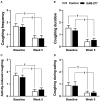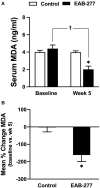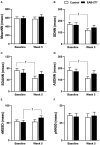Polyunsaturated Fatty Acid EAB-277® Supplementation Improved Heart Rate Variability and Clinical Signs in Tracheal Collapse Dogs
- PMID: 35909680
- PMCID: PMC9330478
- DOI: 10.3389/fvets.2022.880952
Polyunsaturated Fatty Acid EAB-277® Supplementation Improved Heart Rate Variability and Clinical Signs in Tracheal Collapse Dogs
Erratum in
-
Corrigendum: Polyunsaturated fatty acid EAB-277® supplementation improved heart rate variability and clinical signs in tracheal collapse dogs.Front Vet Sci. 2023 Oct 5;10:1296087. doi: 10.3389/fvets.2023.1296087. eCollection 2023. Front Vet Sci. 2023. PMID: 37869500 Free PMC article.
Abstract
Canine tracheal collapse is a progressive disease in small breed dogs resulting from chronic inflammation of the tracheal mucosal lining. Polyunsaturated fatty acid EAB-277® is one of the nutraceuticals that can alleviate inflammation and oxidative stress. Heart rate variability (HRV) is a prognostic tool related to sympathovagal balance and oxidative stress level, which is widely used with cardiorespiratory diseases. However, the effect of EAB-277® on HRV in tracheal collapse dogs has rarely been investigated. In this study, 26 tracheal collapse dogs were divided into two groups. In the control group, the dogs received the standard treatment, whereas the dogs in the EAB-277® group received standard treatment combined with EAB-277®. After being treated for 5 weeks, changes in radiographic findings, blood profiles, serum malondialdehyde, inflammatory markers, and HRV were evaluated. This study found that clinical signs were improved in both groups (p < 0.05). However, serum malondialdehyde (MDA), Interleukin-6 (IL-6), and Tumor necrosis factor-alpha (TNF-α) were decreased only in the EAB-277® group after treatment for five weeks (p < 0.05) and the mean percent change of MDA, IL-6, and TNF-α at week five compared to baseline in the EAB-277® group was greater than in the control group (p < 0.05). Additionally, greater sympathovagal imbalance indicated by decreased standard deviation of all normal R-R intervals (SDNN) and standard deviation of the averaged R-R intervals for all 5-minutes segments (SDANN) was found in the control group at week five compared to baseline (P < 0.05), whereas EAB-277® improved SDNN and SDANN and decreased low frequency/high-frequency component (LF/HF ratio) after being treated for five weeks (P < 0.05). This study demonstrates that EAB-277® improves clinical signs and attenuates HRV impairment by reducing oxidative stress and inflammation in tracheal collapse dogs.
Keywords: dog; heart rate variability; inflammatory marker; malondialdehyde; polyunsaturated fatty acid EAB-277®; tracheal collapse.
Copyright © 2022 Mektrirat, Rueangsri, Keeratichandacha, Soonsawat, Boonyapakorn and Pongkan.
Conflict of interest statement
The authors declare that the research was conducted in the absence of any commercial or financial relationships that could be construed as a potential conflict of interest.
Figures






Similar articles
-
Preliminary Study on Treatment Outcomes and Prednisolone Tapering after Marine Lipid Extract EAB-277 Supplementation in Dogs with Immune-Mediated Hemolytic Anemia.Vet Sci. 2023 Jun 30;10(7):425. doi: 10.3390/vetsci10070425. Vet Sci. 2023. PMID: 37505830 Free PMC article.
-
Corrigendum: Polyunsaturated fatty acid EAB-277® supplementation improved heart rate variability and clinical signs in tracheal collapse dogs.Front Vet Sci. 2023 Oct 5;10:1296087. doi: 10.3389/fvets.2023.1296087. eCollection 2023. Front Vet Sci. 2023. PMID: 37869500 Free PMC article.
-
Acupuncture Improves Heart Rate Variability, Oxidative Stress Level, Exercise Tolerance, and Quality of Life in Tracheal Collapse Dogs.Vet Sci. 2022 Feb 18;9(2):88. doi: 10.3390/vetsci9020088. Vet Sci. 2022. PMID: 35202341 Free PMC article.
-
Mechanisms of morbidity and mortality from exposure to ambient air particles.Res Rep Health Eff Inst. 2000 Feb;(91):5-88; discussion 89-103. Res Rep Health Eff Inst. 2000. PMID: 10817681 Review.
-
Effect of exercise training on heart rate variability in type 2 diabetes mellitus patients: A systematic review and meta-analysis.PLoS One. 2021 May 17;16(5):e0251863. doi: 10.1371/journal.pone.0251863. eCollection 2021. PLoS One. 2021. PMID: 33999947 Free PMC article.
Cited by
-
Assessment of MMP-9 and clinical characteristics in dogs with tracheal collapse based on cough severity and fluoroscopic findings: a cross-sectional study.BMC Vet Res. 2024 Feb 10;20(1):52. doi: 10.1186/s12917-023-03872-1. BMC Vet Res. 2024. PMID: 38341543 Free PMC article.
-
Preliminary Study on Treatment Outcomes and Prednisolone Tapering after Marine Lipid Extract EAB-277 Supplementation in Dogs with Immune-Mediated Hemolytic Anemia.Vet Sci. 2023 Jun 30;10(7):425. doi: 10.3390/vetsci10070425. Vet Sci. 2023. PMID: 37505830 Free PMC article.
References
-
- Hedlund CS. Tracheal collapse. Probl Vet Med. (1991) 3:229–38. - PubMed
LinkOut - more resources
Full Text Sources
Research Materials
Miscellaneous

